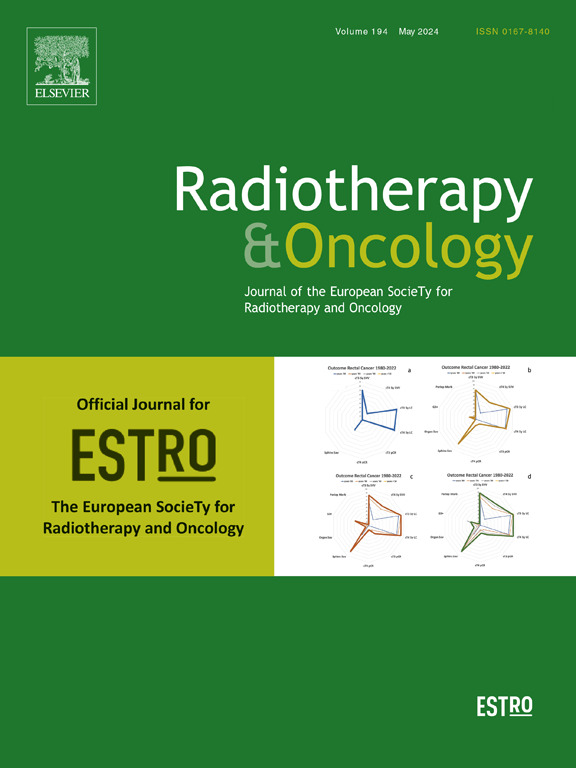p16状态或对诱导化疗的反应,可预测接受确定性放疗的中国口咽癌患者的生存预后吗?
IF 4.9
1区 医学
Q1 ONCOLOGY
引用次数: 0
摘要
目的 确定p16状态或对诱导化疗(IC)的反应是否能预测中国口咽鳞癌(OPSCC)的放疗(RT)反应和生存结果。方法 对211例患者进行分析,包括128例p16阳性和83例p16阴性患者。所有患者均接受了IC治疗,随后接受了明确的RT或同期化放疗(CCRT)。结果 不同p16状态亚组之间的年龄、性别、吸烟史、酗酒史和原发部位不平衡。在 PSM 前,p16 阳性组和 p16 阴性组对 IC 的客观反应率分别为 80.5 % 和 85.5 %(p = 0.344)。RT 后,完全应答率(CR)分别为 73.4 % 和 66.3 %(p = 0.264)。在p16阳性和p16阴性患者中,IC敏感(IC-s)亚组的RT-CR率均高于IC耐药(IC-r)亚组。IC-s 在癌症特异性生存期(CSS)(92.9 % vs. 53.6 %,p < 0.0001)、无进展生存期(PFS)(p < 0.0001)、局部无复发生存期(LRFS)(p < 0.0001)和无远处转移生存期(DMFS)(p = 0.025)方面均有明显改善。在 PSM 之后,不同 p16 组别在 RT 之后的 CR 率仍然相当(71.2% vs. 65.8%,p = 0.476)。在 PSM 之前或之后,不同 p16 状态的 IC-s 或 IC-r 亚组的 CSS、PFS、LRFS 和 DMFS 相似(p > 0.05)。IC-r与较短的PFS(HR=2.661,P=0.002)和LRFS(HR=2.876,P=0.002;HR=2.78,P=0.018)独立相关。无论是p16阳性还是p16阴性的OPSCC,对IC反应差都与预后不理想有关。本文章由计算机程序翻译,如有差异,请以英文原文为准。
p16 status or response to induction chemotherapy, which predicts survival outcomes in Chinese oropharyngeal cancer treated with definitive radiotherapy?
Purpose
To identify whether p16 status or response to induction chemotherapy (IC) predicts the radiotherapy (RT) response and survival outcomes in Chinese oropharyngeal squamous cell carcinoma (OPSCC).
Methods
A total of 211 patients, including 128 p16-positive and 83 p16-negative were analyzed. All patients underwent IC followed by definitive RT or concurrent chemoradiotherapy (CCRT). Propensity score matching (PSM) was used to eliminate the baseline variations.
Results
Age, sex, smoking history, alcohol history, and primary site were unbalanced between different p16 status subgroups. Before PSM, the objective response rates to IC between p16-positive and p16-negative groups were 80.5 % and 85.5 % (p = 0.344). After RT, the complete response (CR) rates were 73.4 % and 66.3 %, respectively (p = 0.264). IC-sensitive (IC-s) subgroups had a higher percentage of RT-CR rate than the IC-resistant (IC-r) subgroups in both p16-positive and p16-negative patients. IC-s showed significant improvement in cancer-specific survival (CSS) (92.9 % vs. 53.6 %, p < 0.0001), progression-free survival (PFS) (p < 0.0001), locoregional relapse-free survival (LRFS) (p < 0.0001) and distant metastasis-free survival (DMFS) (p = 0.025). After PSM, the CR rates among different p16 groups remained comparable following RT (71.2 % vs. 65.8 %, p = 0.476). Before or after PSM, CSS, PFS, LRFS, and DMFS were similar between different p16 status either in IC-s or IC-r subgroups (p > 0.05). IC-r was independently associated with shorter PFS (HR = 2.661, p = 0.002) and LRFS (HR = 2.876, p = 0.002; HR = 2.78, p = 0.018).
Conclusions
Response to IC is an important predictor of prognosis in Chinese OPSCC treated with definitive RT. Poor response to IC is associated with unsatisfactory outcomes either in p16-positive or p16-negative OPSCC.
求助全文
通过发布文献求助,成功后即可免费获取论文全文。
去求助
来源期刊

Radiotherapy and Oncology
医学-核医学
CiteScore
10.30
自引率
10.50%
发文量
2445
审稿时长
45 days
期刊介绍:
Radiotherapy and Oncology publishes papers describing original research as well as review articles. It covers areas of interest relating to radiation oncology. This includes: clinical radiotherapy, combined modality treatment, translational studies, epidemiological outcomes, imaging, dosimetry, and radiation therapy planning, experimental work in radiobiology, chemobiology, hyperthermia and tumour biology, as well as data science in radiation oncology and physics aspects relevant to oncology.Papers on more general aspects of interest to the radiation oncologist including chemotherapy, surgery and immunology are also published.
 求助内容:
求助内容: 应助结果提醒方式:
应助结果提醒方式:


